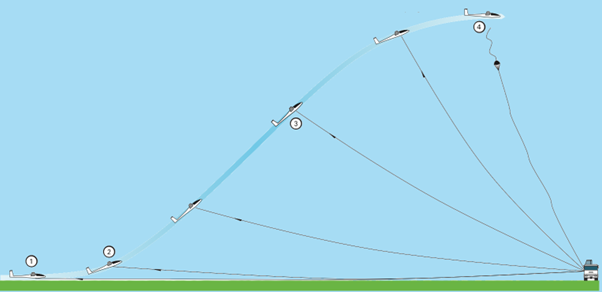Table of Contents
Contents
The Winch's Perspective
You likely are already very accustomed to the process of winch launching from the launch point’s perspective, but what about at the winch?
Stages Of A Launch
This is a diagram you’ve probably seen before during your flight training. It was sourced from the BGA Student Pilot Manual.
1. Ground Run — During the ground run, we want to accelerate the glider quickly and smoothly. The ground run is the most critical part of the winch launch, so we want to get the glider flying as soon as possible.
2. Rotation — As soon as the glider has reached its minimum safe speed, the pilot will start to pull back the stick to bring the aircraft into an (approximately) 45° angle of climb. This rotation should take around 3 to 5 seconds. Whilst the glider can safely overspeed past Vw on the lower portion of the launch, we want to take care not to accelerate the aircraft so fast that they must pull back to manage their speed.
3. Full Climb — Once in the full climb, the glider should stabilize. From this point forward, we may need to make small adjustments to the throttle to keep the glider stable and within the correct speed range. As the glider starts to near the top of the launch, we need to anticipate that the glider will start to speed up and begin backing-off the power.
4. Release — Once the glider has reached the top of the launch, we cut the power well before losing sight of it. Then, the glider will release, and we can begin to reel the cable back to the winch whilst the glider flies off to find lift.
Glider Launch Characteristics
There is a wide range of different private gliders at Portmoak, so you won’t just be launching club aircraft! The K21, Perkoz and Junior are all inherently easy to launch and you will get used to their characteristics rather quickly. However, you may often be faced with a glider you have never launched before.
Skylaunch have published the ‘Skylaunch Suggested Throttle Guide Setting Chart’ for use with the Skylaunch 2. A full copy of this is stored in the winch’s cabin. It includes information such as the weak link used, maximum take-off mass, suggested speeds, and throttle guide settings for most common aircraft.
Here is the entry for the K21. It tells us that we should be using a black link and that we want the aircraft to maintain 60 to 65 knots in the full climb (its maximum is 81 knots). It also suggests that we should set our throttle guide setting to A, which is here:
Now, let’s look at something else, such as a Bocian 1D:
As you can see, our recommended speed range has shrunk to only 50 to 54 knots, and our maximum (Vw) is 54 knots too! We are not provided with much space for error. Our throttle guide setting has also been lowered to C. This means we can expect that the Bocian will require substantially less power than a K21 and that it will likely take-off sooner.
External Factors
Wind Speed
The wind can substantially change the amount of power required to launch a glider. Unfortunately for the purpose of this guide, I’m about to take you back to some Bronze-level aerodynamics you thought you had escaped from!
Imagine a glider is stationary on the ground, with its leading edges pointing directly into wind. If there is little to no wind, the glider may start the launch with no airflow over its wings. This means the wings, whilst stationary, are generating no lift and the glider must be forced through the air to begin to create any amount of lift. This requires a substantial amount of power from an external source (such as the winch or the tug plane’s engine).
When we increase the wind speed, the airflow over the glider’s wings increases. As the glider’s wings are already creating some lift, less power is required from the winch to launch the glider. This is why the winch is fitted with a selector for the current ground headwind component.
Gliders will require MORE POWER to launch as the HEADWIND component is DECREASED.
Keep in mind that the glider’s headwind component is not always the wind speed. For example, if the wind is a direct 10 knot northerly (0°) and the glider is facing directly east (90°), the actual headwind component is 0 knots.
Crosswinds
When we winch launch with a crosswind component, as pilots, we must lower the upwind wing to fly straight ahead. Whilst crosswinds are unlikely to affect the launch from the winch driver’s perspective, we must be prepared to drop any glider which fails to compensate correctly where the cable could land outside the airfield’s boundaries or on-top of an object.
Gusty Conditions
When the winds are particularly gusty, the risk of spikes in pressure asserted over the cable and the weak link is greatly increased. Therefore, we need to be especially careful with speed during gusty conditions and we must carefully monitor the pressure gauge.
Pilot Experience
Whilst most of the launches you provide will be for relatively experienced pilots, Portmoak welcomes many pilots who are new to winch launching or even completely new to flying altogether.
New pilots may overcorrect or become unstable during the climb. They may also over- or under-use the rudder or ailerons, both of which can cause the glider to yaw. The best thing we can do in these situations is continuing to provide stable power instead of ‘fighting’ them whilst trying to stabilise their launch. Keep in mind that the instructor will take control if the student becomes too unstable.




